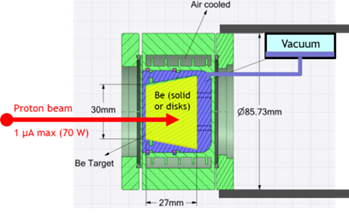PRIN 2022 / Campagnolo

Acronimo: CoolGal
Titolo: A liquid metal-cooled Beryllium target for a proton-induced Neutron Production
Responsabile scientifico: dott. Alberto CAMPAGNOLO- Dipartimento di Ingegneria Industriale-Università degli Studi di PADOVA
Coordinatore: prof. Alberto MONETTI– Istituto Nazionale di Fisica Nucleare
Partner-Unità di ricerca: Dipartimento di Ingegneria Industriale-Università degli Studi di PADOVA , Università degli Studi di CASSINO e del LAZIO MERIDIONALE
Bando: PRIN 2022 - Decreto Direttoriale n. 104 del 02-02-2022
Durata: 28/09/2023 - 27/09/2025 (24 mesi)
Budget totale progetto: € 223.680,00
Abstract del progetto
The aim of CoolGAL is the study, design, and test of an innovative target system for proton induced neutron production. It is an important part of the NEPIR (NEutron and Proton IRradiation) facility designed for the SPES (Selective Production of Exotic Species) project, the ISOL (Isotope mass Separation On-Line) facility under construction at LNL; the facility will be driven by the SPES cyclotron which can supply 35-70 MeV protons with currents in the order of 200-500 µA.
NEPIR is designed to be a versatile fast neutron (E > 1 MeV) irradiation facility that will be unique in Italy and a reference point for European research, for science (applied and basic) and industry. It is planned to be constructed in phases according to the availability of funds and it will produce:
1. an intense beam of fast neutrons with a continuous energy distribution similar to that of fast atmospheric neutrons in the 1-70 MeV energy range found at flight-altitudes and at sea-level (phase 0).
2. an intense Quasi Mono-energetic Neutron beam (QMN) with a controllable energy peak in the 20-70 MeV energy range (phase 1);
The construction of the CoolGal target for the phase 0 of NEPIR (Figure 1) will allow the production of continuous energy (white spectrum) neutron beams and to study the capability of the target to sustain high powers. CoolGal is an innovative target system where a Beryllium (Be) target is immersed in a static bath of liquid metal (eutectic alloy of Ga, In and Sn known as Galinstan). The liquid metal ensures a good convection cooling of the Be target transferring the power to the external finned area of the cladding, which can be cooled by forced water flow.
A continuous energy distribution neutron beam, simulating the atmospheric neutron spectra, is fundamental to study energy neutron induced Single Event Effects (SEE) in electronics. These effects in state-of-the-art electronics show a very strong energy dependence in the 0.2-to-few tens of MeV neutron energy range, which can vary significantly across different technologies. Such studies are of strategic importance for the many applications of electronics in industry and research: Fission and future Fusion Reactors, Nuclear Medicine, High Energy Physics, Space Applications, Aviation, Information, and Automotive industries.

Figure 1 Conceptual representation of the CoolGAL target. Proton beam, coming from the left, goes through the window and a Galinstan layer before the thick Be component.





